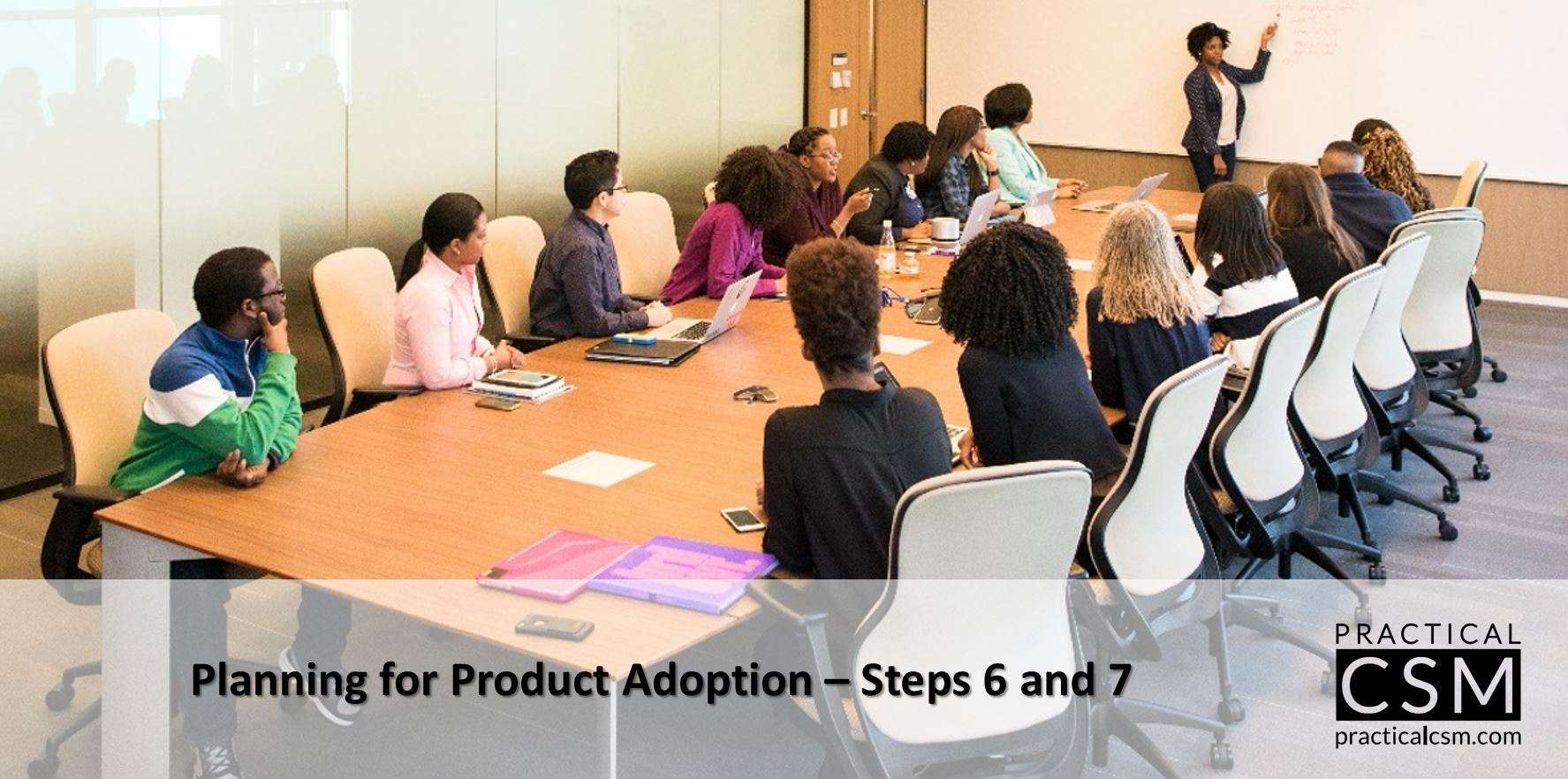Introduction
Depending upon the product (or service) in question, full product adoption can be a potentially quite complex and even onerous task to perform well. As with all complex tasks, the secret is to break it down into its constituent components and then to deal with each component one at a time (as much as possible at least). There are many ways in which product adoption could be divided up and broken down into separate parts. The steps I have divided up adoption planning into are shown below:
Step 1: Determine Adoption Requirements
Step 2: Identify Process Changes
Step 3: Create Impacted Groups (IGs)
Step 4: Document Practical Considerations
Step 5: Determine Communication, Training and Support Requirements
Step 6: Capture Adoption Barriers and Risks
Step 7: Create Outline Adoption Plan
Step 8: Create Adoption Proposal and Gain Acceptance
Step 9: Complete Full Adoption Plan and Publish Adoption Roadmap
In my previous articles I explained the first five steps in adoption planning, taken from Chapter 8 of my book Practical Customer Success Management. This week I’m describing Step Six: Capture Adoption Barriers and Risks as well as Step Seven: Create Outline Adoption Plan. As I have mentioned in the previous articles in this series, being a chapter from the mid to later stages of the book, it does assume knowledge attained from previous chapters, and it also mentions downloadable tools that purchasers of the book have access to. But hopefully as a standalone series of articles it will provide a useful reference for CSMs who are looking for a way to break down the adoption planning process into a series of tasks and to learn how to perform each task efficiently and effectively. Also just to mention that of course adoption planning (and the use of the tools discussed herein) is also covered in detail in my Certified CSM Professional training program and within the upcoming Practical CSM Academy subscription site.
Step 6: Capture Adoption Barriers and Risks
Defining adoption barriers
An adoption barrier is a challenge or obstacle that needs to be dealt with first in order for adoption to take place satisfactorily. Adoption barriers may include (but are by no means limited to):
- Political issues such as lack of support from one or more areas of the business (and especially important if lack of support from senior management)
- Lack of support from the workforce to engage with and support the adoption plan
- Financial issues such as inadequate funding or disagreements relating to which parts of the businesses should contribute towards the budget, or cash flow concerns
- Lack of certainty regarding adoption outcome requirements
- Lack of clarity regarding the changes to one or more processes
- Lack of clarity regarding the impact to one or more IGs
- Lack of authority to proceed with implementing the adoption plan, including authority to take employees’ time away from their work for training or other activities relating to the adoption plan
- Lack of assets and resources required to perform the adoption, including training materials, support services, etc
- Lack of expertise to perform adoption activities, including subject matter experts, trainers, support workers, etc
- Cultural issues relating to the regional and/or corporate culture that might place limitations on the way in which adoption should be planned (for example managers may need to be briefed first before their teams are trained, in order to ensure no loss of face occurs due to managers not knowing what their team knows)
Capturing adoption barriers
The topic of adoption barriers should be brought up with the SPL and/or other key stakeholders within the customer’s organization and the SPL should be encouraged to compile a list of potential barriers either with the CSM and/or with help from their colleagues. This list should be as definitive as possible, however it should be recognized that not all adoption barriers can be known up front, and further barriers may be uncovered after the adoption plan has been created, or even during adoption implementation. An adoption barriers questionnaire has been included as a separate worksheet within the Adoption Requirements Questionnaire (a tool which readers of my book are eligible to download from my website).
Defining adoption risks
Adoption barriers are known obstacles that can therefore be dealt with up front prior to planning or certainly prior to implementing the adoption plan. Adoption risks on the other hand are potential obstacles that may occur if certain circumstances prevail. In other words, adoption barriers deal with what is known, whereas adoption risks deal with what is unknown but possible. Adoption risks may include (but are by no means limited to):
- Changes to corporate strategy leading to changed adoption outcome requirements
- Changes to customer (as in the customer’s customer) requirements, leading to changed adoption outcome requirements
- The unsuccessful completion of other projects or initiatives (for example a dependency on the launch of a new support service)
- Problems with the performance of products or services within the solution (for example a product feature may not work as promised, or a service feature may not function to the promised quality level)
- Changes to external conditions (for example a macro economic downturn, new legislation, or new competitive offerings)
- Changes to senior personnel, leading to business reorganization and reduction in support or necessity for the implementation
- Mergers or acquisitions that might take precedence in terms of time and availability of assets and resources away from the implementation and/or might significantly impact the adoption requirements
Capturing adoption risks
The topic of adoption risks should also be brought up with the SPL and/or other key stakeholders within the customer’s organization and as with barriers the SPL should be encouraged to compile a list of potential risks either with the CSM and/or with help from their colleagues. Again as before, this list should be as definitive as possible, however it should be recognized that not all adoption risks can be known up front, and further risks may be uncovered after the adoption plan has been created, or even during adoption implementation. An adoption risks questionnaire has also been included as a separate worksheet within the Adoption_Requirements_Questionnaire.
Step 7: Create Outline Adoption Plan
Ownership of the adoption plan
This is the step where all of the information that the CSM and others have researched and collated is analyzed and used to determine the customer’s adoption requirements. Generally speaking, the best way to approach this analysis is to work in close partnership with the SPL and/or other relevant customer stakeholders to develop a high level adoption plan. The plan that is developed should be owned by the SPL and the customer, with the CSM providing input in terms of advice and assistance, rather than being owned by the CSM.
Working in partnership with the customer to help develop an adoption plan which is created and owned by them has several advantages. Firstly, the plan that is developed is likely to be higher quality since it incorporates both the ideas of those who actually work for the customer and know the organization best as well as the ideas of the CSM (and others as necessary from the CSM’s organization and third party organizations who have supplied other parts of the solution) who are experts in the solution itself and who have had useful experience of previous adoption cycles of the same or similar solution in other companies. Secondly, from a political perspective, the initiative’s sponsors and other senior decision makers within the customer organization are more likely to be persuaded by and supportive of an adoption proposal that has been created by the company’s own experts (with help from the CSM and others). Finally, the responsibility for the plan’s completeness and appropriateness to need should ultimately rest with the SPL and the customer rather than with the CSM and the CSM’s company. This matches the overall role and responsibilities of the CSM to provide advice, assistance and access to resources to the customer rather than to make business decisions on behalf of the customer.
Preparing to analyze the information
There are various ways in which the planning process can be conducted. The important thing is to find a methodology that suits the needs of the customer and that fits the specific circumstances such as availability of people, format of information, etc.. The simplest way or working is often the most effective. My recommendation is to arrange a face-to-face meeting of an appropriate length (depending upon complexity) with the SPL and any others who will participate in the planning process. Make sure that there will be access to all of the information that you have researched and try as much as possible to find a location that is reasonably comfortable and where you will not be interrupted or disturbed.
Try if you can to spend some time reviewing the information on your own and make some personal notes ahead of the meeting, so you are well informed and ready to participate in the meeting itself. This also gives you the opportunity to review some of the documentation you have created in previous Phases within the Practical CSM Framework but which you may not wish to share with customer employees. These might include the Customer Engagement Strategy created in Phase 1: Preparation and the RACI Matrix, the Stakeholder Management Matrix and the Stakeholder Management Plan created in Phase 2: Commitment.
Information that you might wish to ensure you and others have access to during the meeting include (though is not limited to):
- A company org chart and/or other reference information regarding the customer’s organizational model, preferably including information on what each department is responsible for and the roles and numbers of the employees within it.
- The Customer Research Checklist document that you created in Practical CSM Framework Phase 1: Preparation and have subsequently referenced and updated in Phases 2, 3 and 4.
- The Customer Engagement Proposal that you created in Practical CSM Framework Phase 2: Commitment.
- The Onboarding Work Plan that you created in Practical CSM Framework Phase 3: Onboarding.
- The Adoption Requirements Questionnaire that you created in this phase; Practical CSM Framework Phase 4: Adoption Planning.
Performing the analysis and producing and outline adoption plan
Performing the analysis should be reasonably straightforward. You should now have all (or the vast majority of) the information you need to complete the task, so the job is not unlike putting together a jigsaw puzzle now that you have all the pieces out on the table.
The recommended start point is to review the customer’s adoption outcome requirements to make sure that these outcome needs are foremost in everyone’s mind during the analysis. Then it is a question of working through the different IGs and agreeing on what the adoption needs of each IG are and how they can best be met given the restraints on assets and resources and any other restrictions or factors to take into account you may have previously noted. These factors might include time, money, availability, deadlines, dependencies, etc. What you are looking to achieve is an outline or high level plan that simply summarizes what needs to be done and in what order it needs doing without necessarily going into any detail at this early stage.
If the initiative has sufficient complexity to warrant doing so it can be a good idea to first prioritize the adoption needs of each IG into groups of higher and lower priority, and then to deal with each priority group separately, using the Adoption Requirements Questionnaire, as the core documentation, and using each worksheet contained within it as necessary to ensure that all requirements are met and that barriers and risks are dealt with appropriately within the plan that you formulate. Review and discuss the highest priority group’s adoption requirements and formulate an outline or high level plan for meeting those needs. Once you have dealt with the highest priority group, move to the next highest priority group and so on until all IGs’ adoption requirements have been reviewed and discussed and you have an outline plan for all adoption requirements.
It’s a good idea to capture discussions and ideas as they come up even if they relate to something you are not discussing at that moment, so that you can refer back to them later when it is the right time to cover that particular topic. The outline adoption plan can be created in any format. If desired the Outline Adoption Plan template that can be found in the Downloads section at www.practicalcsm.com can be used for this purpose.
Adoption activities for successful change management
The following are the most common adoption activities or components that should be discussed and where necessary defined for each IG:
| Component | Description |
| Initial Communication | Impacted users need to be informed well in advance of the upcoming changes in order to help them prepare both emotionally and practically for these changes. An early communication should explain what will happen, why it is occurring and how those users will be affected. This initial communication should attempt where possible to allay any unnecessary fears or concerns about coping with new activities, and reassure users that they will be fully supported through the change |
| Follow Up | Opportunities may need to be provided for users who have recently been made aware of upcoming changes to ask further questions about the changes and about the consequences of those changes to their own role and activities. These might be handled partially by direct managers in team or departmental meetings and/or access to HR or change management specialists who can answer questions in confidence |
| Preparation for Change | Any activities that need to occur and/or assets and resources that need to be available prior to the changes occurring should be detailed here. This might include further communications around upcoming important dates when change management activities will occur, testing of new software systems, creation of process documentation, customization of training content, etc. |
| Undergoing Change | Any activities that need to occur and/or assets and resources that need to be available during the change should be detailed here. This might include communications about accessing new systems and services, training on using new systems and following new processes, access to new systems and services and supporting documentation, access to online and other help and support systems, etc. |
| Post Change Support | Any ongoing activities to continue supporting the users after the change has occurred. This might include coaching and/or mentoring, and ongoing access to help and support services. |
| KPIs and Measurement | This section should identify how the change management activities and resulting change in KSA (knowledge, skills and attitude) will be measured and evaluated to ensure effectiveness |
Uncovering further information requirements
As you work through the analysis of IG requirements you may find that one or more questions arise that cannot be answered without further research. These questions might relate anything at all, for example to IG needs, or to availability of an asset or resource, or to suitability of a certain training method, etc. You may therefore need to decide whether to proceed on the basis of an assumption about the missing information which can be validated at a later stage if necessary, or whether the missing information is sufficiently important to need to be researched now, prior to completion of the planning process.
Reviewing the outline adoption plan
Once you have completed a first pass of the adoption planning process, it generally makes good sense to go back through the plan again. This might take place separately once further information requirements have been researched and the information has been added to the documentation. In any case it is a good idea to do this separately after a few days have elapsed if possible, since it brings fresh energy and perspective to the conversation.
At this point you are not necessarily trying to fill in all of the detail, but what you do need to do is ensure that the basic outline is correct.
Managing Adoption Barriers
Once the outline adoption plan is created and has been reviewed and amended as necessary, you should review your adoption barrier documentation to make sure that adoption barriers have been addressed sufficiently within the plan and if necessary making further amendments to the plan to ensure they are now addressed.
Managing Adoption Risks
General risk management best practice is to rate risks according to both the level of impact that will be experienced if the risk occurs and the likelihood of the risk occurring. The second tab within the Adoption Risks Questionnaire document contains a simple matrix to help with scoring risks. Each risk is given a rating from 1 to 5 for both the likelihood of its occurrence and the impact to the business if it does occur, and then these two ratings are combined to give an overall score. Risks with a score above a certain number (for example above 7) can then be classified as High Priority. Risks with a score below a certain number (for example below 5) can be classified as Low Priority, and risks with an intermediate score can be classified as Medium Priority. The risk scoring matrix is shown below:

Any risk that is calculated to be a medium or high priority risk will need a strategy either for avoiding the risk entirely through changes made to the adoption plan or through specifying the actions to be taken for dealing with the risk should it occur. Low priority risks can either be treated in the same way as medium or high priority risks or simply ignored if the risk priority is sufficiently low.
A list of risks and actions for dealing with them should be included in the outline adoption plan, and there is a place in the Outline Adoption Plan template for them.







